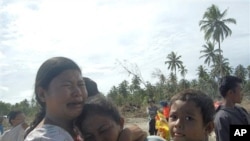As Indonesia continues counting its dead from back-to-back natural disasters this week, officials are debating the effectiveness of the country's tsunami warning system. The combination of a tsunami and a near-simultaneous volcanic eruption has left at least 343 people dead, a number that is expected to climb.
Thursday, rescue officials got a clearer picture of the damage a tsunami inflicted on Indonesia's remote Mentawai Islands, which swept away hundreds of homes and lives.
Failed system
A meteorology agency official says an early warning system implemented after the 2004 Indian Ocean tsunami failed.
The system was created to warn people to move to higher ground in the threat of a giant wave. But the official says it had been plagued by problems caused in part by inexperienced operators.
The 10-foot waves that wiped out entire villages, hit the Mentawais only minutes after the 7.7-magnitude earthquake that triggered it. But the head of the Meteorology and Geophysics Agency, Wandono, says the local government still had time to sound an alarm.
He says the agency released information about the earthquake and possible tsunami almost immediately. If the local government had used that information, it could have reduced the number of victims.
Supplies needed
After being delayed by bad weather, food, tents and clothing are arriving on the islands. Officials say they now expect a steady stream of supplies.
Groups of surfers who were some of the first to reach the scene say clothing is badly needed, since many people were left with nothing but what they were wearing. Arial photos show uprooted trees and concrete foundations that had been cleared of their wooden houses.
With rescue workers starting to arrive, search parties set out through the island's jungles to look for the hundreds of people still missing.
Removing ash
About 1,300 kilometers to the east, rescue workers are assisting nearly 40,000 evacuees around Mount Merapi, a volcano in Central Java that began spewing searing ash and debris Monday evening.
Authorities continue to search the ash-covered slopes for survivors, and volunteers are removing dead livestock to prevent the spread of disease.
Many of the victims suffered from severe burns caused by hot clouds of gas that swept down the mountain.
Ignored warnings
Among the victims was a respected elder who many residents considered the mountain's spiritual guardian, charged with appeasing fickle spirits.
Widi Sutikno, head of emergency response in the district of Sleman, says local beliefs were the reason many of those who live on the volcano ignored earlier evacuation warnings.
He says officials urged people to evacuate, but residents believed their own local wisdom would tell them when it was the right time to leave. Sutikno says because of rain and bad weather, they could not see the hot gas clouds.
Another explosion?
Tuesday's blast eased pressure building up beneath a lava dome. Since then the volcano has been largely quiet, but scientists have not ruled out the possibility of an even larger explosion.
President Susilo Bambang Yudhoyono headed to Sumatra after cutting short a visit to Vietnam to help manage the government's response to both disasters.











